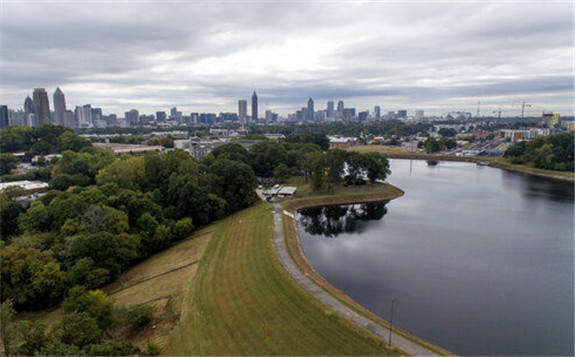
Water was coming over the top of a nearby hydroelectric dam, they told him before fleeing in their truck.
Minutes later, the swollen Niobrara River crashed through Spencer Dam, unleashing a wave of water carrying ice chunks the size of cars. Angel’s home was wiped away; his body was never found.
“He had about a 5-minute notice, with no prior warning the day before,” Scott Angel, one of Kenny’s brothers, said.
State inspectors had given the dam a “fair” rating less than a year earlier. Until it failed, it looked little different from thousands of others across the U.S. — and that could portend a problem.
A more than two-year investigation by The Associated Press has found scores of dams nationwide in even worse condition, and in equally dangerous locations.
The review of federal data and reports obtained under state open records laws identified 1,688 high-hazard dams rated in poor or unsatisfactory condition as of last year in 44 states and Puerto Rico. The actual number is almost certainly higher, because some states declined to provide condition ratings for their dams.
Deaths from dam failures have declined since a series of catastrophic collapses in the 1970s prompted the federal and state governments to step up their safety efforts. Yet about 1,000 dams have failed over the past four decades, killing 34 people, according to Stanford University’s National Performance of Dams Program.
The nation’s dams are over a half-century old on average. Some are no longer adequate to handle the intense rainfall and floods of a changing climate. Yet they are being relied upon to protect more and more people as housing developments spring up nearby.
“There are thousands of people in this country that are living downstream from dams that are probably considered deficient given current safety standards,” said Mark Ogden, a former Ohio dam safety official who is now a technical specialist with the Association of State Dam Safety Officials.
Dams are categorized as high, significant or low hazard in the National Inventory of Dams database. High hazard means loss of human life is likely if a dam were to fail. A significant rating means no deaths are likely, although economic and environmental damage are possible.
Dam conditions are supposed to be rated by inspectors as unsatisfactory, poor, fair or satisfactory. But the ratings are subjective — varying by state and the interpretations of individual inspectors — and are not always publicly disclosed.
Since the Sept. 11, 2001, terror attacks, the U.S. government has cited national security grounds in refusing to include the condition of dams in its inventory, which was updated most recently in 2018. But the AP was able to determine both condition and hazard ratings for more than 25,000 dams across the country through public records requests.
The AP then examined inspection reports for hundreds of high-hazard dams in poor or unsatisfactory condition. Those reports cited a variety of problems: leaks that can indicate a dam is failing internally; unrepaired erosion from past instances of overtopping; holes from burrowing animals; tree growth that can destabilize earthen dams; and spillways too small to handle a large flood.
Georgia led the nation with nearly 200 high-hazard dams in unsatisfactory or poor condition, according to the AP’s analysis.
Among them is Reservoir No. 1 in Atlanta, a 180 million-gallon water supply dating to the late 1800s that has been out of service much of the past few decades. The city made repairs and brought it back online in 2017, only to shut it down again after leaks were noticed.
Were the dam to catastrophically fail, the water could inundate more than 1,000 homes, dozens of businesses, a railroad and a portion of Interstate 75, according to an emergency action plan .
Joel Iverson has previously noticed water trickling out of the dam near the brewery he co-founded, Monday Night Brewing.
“If that one goes, it’s going to wash away us and a lot of beer,” Iverson said.
The Atlanta Watershed Management Department declined the AP’s request for an interview about the reservoir and instead asked for questions in writing. When those were submitted, it declined to answer them.
Every state but Alabama has a dam safety program. But the Great Recession a decade ago forced many states to make widespread budget and personnel cuts.
Since a low point in 2011, states’ total spending on dam safety has grown by about one-third to nearly $59 million in the 2019 fiscal year while staffing levels have risen by about one-fifth, according to data collected by the U.S. Army Corps of Engineers.
California, which runs the nation’s largest dam safety program, accounts for much of that gain. It boosted its budget from $13 million to $20 million and the number of full-time staff from 63 to 77 following the failure of the Oroville dam spillway in 2017.
But some states have continued to pare back their dam safety programs. Thirteen states and Puerto Rico were spending less in 2019 on dam safety programs than they did in 2011, and 11 states had fewer full-time positions in their programs, according to the Corps data.
The Association of State Dam Safety Officials estimates it would take more than $70 billion to repair and modernize the nation’s more than 90,000 dams. But unlike much other infrastructure, most U.S. dams are privately owned. That makes it difficult for regulators to require improvements from operators who are unable or unwilling to pay the steep costs.
“Most people have no clue about the vulnerabilities when they live downstream from these private dams,” said Craig Fugate, a former administrator of the Federal Emergency Management Agency. “When they fail, they don’t fail with warning. They just fail, and suddenly you can find yourself in a situation where you have a wall of water and debris racing toward your house with very little time, if any, to get out.”